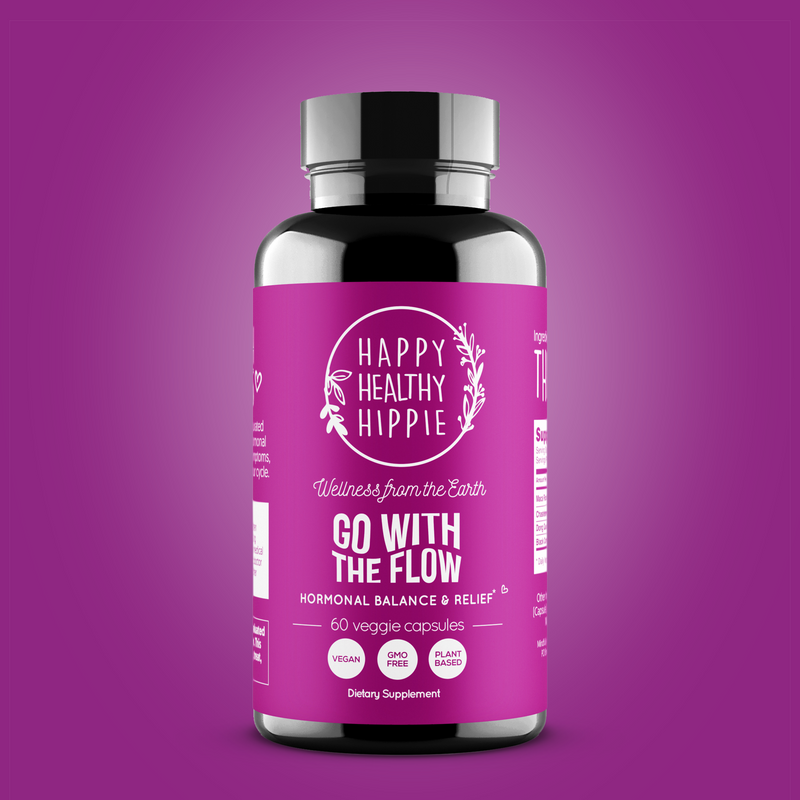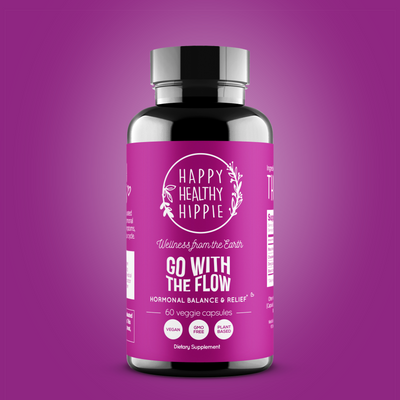![Woman in front of a sunset - High Estrogen in Women [What Causes It & How to Fix It]](http://happyhealthyhippieco.com/cdn/shop/articles/high_estrogen_in_women_featured_image.jpg?v=1624560402)
High estrogen in women can trigger a range of total-body conditions and issues that can make daily life challenging.
Most people already know that estrogen is the primary hormone needed by a woman’s ovaries to complete the menstrual cycle.
But only a few people know that estrogen controls a lot more than a woman’s period. In fact, high estrogen affects many women’s development, wellness, and overall quality of life.
This article looks into some of the main causes of high estrogen in females, and what you can do to re-balance it.
Read on to find out:
- What is Estrogen?
- High Estrogen in Women — What Does It Mean?
- High Estrogen in Women Symptoms
- What Causes High Estrogen in Females?
- How Do You Fix High Estrogen in Women?
What is Estrogen?
Estrogen is one of the two main reproductive hormones in women -- the other being progesterone. Specifically, it helps women’s bodies sexually develop and regulates other essential functions such as:
- Urinary tract health
- The reproductive system
- Hair growth on the body
- Heart and blood vessels (especially the control of cholesterol levels)
- Development of “secondary” sex characteristics such as the breasts
- Mucous membranes
- Pelvic muscles
- Brain development
- Skin health (especially by maintaining elastin and collagen, which give the skin a youthful glow, natural bounce, and protection)
Even though the bodies of biological males produce low levels of estrogen, this hormone plays a key role during puberty for those assigned female at birth.

University of Rochester Medical Center
In fact, estrogen is so crucial that researchers have found that even facial appearance holds “detectable cues to reproductive health” and estrogen levels in the body.
Before menopause, women generate estrogen primarily from the ovaries. During and after menopause, they produce estrogen from fat cells and the adrenal glands, positioned above the kidneys.
The female body produces three types of estrogen, depending on what phase a woman is in:
- Estrone — the type of estrogen produced by the body post-menopause.
- Estradiol — the type of estrogen produced by non-pregnant women of child-bearing age.
- Estriol — the type of estrogen hormone produced by pregnant women.

It’s rather remarkable how these estrogen variations occur based on the various cycles in a woman’s life. That’s why, for example, the main role of estradiol is to mature and maintain the reproductive system in women of childbearing age.
The female body relies on high estradiol levels during the menstrual cycle to trigger the maturation and release of the egg and thicken the uterine wall in case an egg is successfully fertilized.
Even in biological males, optimal estradiol levels help maintain bone health, contribute to the production of nitric oxide (important for heart health and male libido), and enhance brain function.
High Estrogen in Women — What Does It Mean?
High estrogen in women is a clear indicator that you have a hormonal imbalance. While your body needs estrogen — whether as estradiol, estrone, or estriol — too much can be just as problematic as not enough of it.
An increased risk of breast and ovarian cancers is among the most serious health concerns associated with high estrogen. Women using hormone therapy to alleviate menopause symptoms face the same risk, because the therapy may increase estrogen levels to the point where they’re too high.
Additionally, high estrogen levels lead to a higher chance of cardiovascular disease, osteoporosis, menstrual issues, constipation, and weight gain that’s extremely hard to get rid of (such as belly fat).
High Estrogen in Women Symptoms
High estrogen in women comes with a lengthy list of symptoms that you just can’t miss. These include:
- PMS
- Adult acne
- Bloating
- Fertility issues
- PCOS
- The occurrence of ovarian cysts
- Irregular menstrual cycles
- Thyroid dysfunction
- Fatigue
- Headaches
- Mood swings
- Thinning hair or hair loss
- Cold hands and/or feet
- Brain fog
- Low libido
- Weight gain
- Interrupted sleep or insomnia
- Swollen or tender breasts
- Potential for endometriosis
- Development of fibrocystic lumps in the breasts
- Depression
- Anxiety or panic attacks
Go With The Flow is a 100% plant-based supplement that supports you by:
- Menopause and PMS relief through herbal remedies
- Balancing hormone levels
- Providing mental & emotional relief
- Reducing bothersome physical symptoms (acne, bloating, etc.)
Try it risk free with our 60-Day Money Back Guarantee.
What Causes High Estrogen in Females?
Pay close attention to what you eat, which products you use, and how you deal with stressful situations in your life: these rather unremarkable, everyday experiences are some of the most common causes of high estrogen in females.
Let’s take a look at seven sources responsible for high estrogen in females.
#1. Hormonal Contraceptives
The number one cause of high estrogen in women right now is the use of hormonal contraceptives like birth control pills and IUDs (also known as intrauterine devices).
From the patch to the pill to the ring, the key to hormonal contraceptives is that they chemically alter the body’s natural hormone balance.
Now, the majority of women use contraceptives as the best way to prevent accidental pregnancy.

However, women also use these birth control options to address other issues such as mood swings, migraines, and acne.
The side effects of these contraceptives also help lighten or shorten the menstrual flow and cycle, which can be helpful for women who experience heavy or painful periods.
Finally, hormonal contraceptives can help regulate an otherwise irregular menstrual cycle.
However, the changes that these prescriptions cause in your body may be more adverse than positive. Contraceptives are thought to trigger a high production of estrogen in women, leading to the imbalances that cause the exact symptoms they were trying to avoid: mood swings, acne, headaches, and irregular periods.
#2. Certain Antibiotics
Speaking of medications, several antibiotics can wreak havoc on hormone balance.
You may already know that medications like antibiotics scrub the body clean of good bacteria (which is why so many individuals contract yeast infections if they don’t supplement with a probiotic).
However, certain medications also interact with your body’s natural chemistry in ways that increase estrogen in females.
Watch out for the following medications known to trigger high estrogen in women:
- Tetracycline
- Phenothiazines (a group of antipsychotics)
- Clomiphene
- Corticotropin
#3. Beauty or Personal Care Products
The skin is supposed to act as a protective barrier for our most delicate internal organs. But even skin is vulnerable — in fact, as the body’s largest organ, skin can absorb up to 70% of what sits on the surface.
It also happens that beauty and personal care products like makeup, shampoos, shower gels, body lotions, soaps, and sunscreens contain a significant hormone disruptor known as xenoestrogens.

This chemical artificially increases estrogen levels in women, which disrupts thyroid function as well. The connection between oestrogens and the thyroid would also explain why xenoestrogens contribute to the malfunction of your thyroid gland (and thyroid hormones).
Hyper- and hypothyroidism come with a range of serious symptoms that can affect the quality of life. In pregnant women, the risk passes on to fetal development, critically increasing the risk of neurodevelopmental diseases in newborns.
#4. Unfermented Soy Products
The debate on whether soy products are harmful carries on. Many individuals argue that high rates of soy consumption in Eastern countries like Japan and China are linked to higher health quality and longevity.
If soy really was hormone-disruptive, wouldn’t it affect these consumers too?
There’s a caveat to soy products — and that’s fermentation. See, unfermented soy products contain three hormone disruptors. Even though they’re “naturally occurring,” they’re not good news for your body’s estrogen levels.
- Goitrogens — Goitrogenic foods contain a substance called goitrogens that disrupts the production of thyroid hormones by blocking iodine uptake. Incidentally, iodine happens to be a natural hormone balance supplement you can take if you have a deficiency.
- Phytoestrogens — These are plant estrogens that mimic estrogen in the human body. The research on whether phytoestrogens cause or protect against breast cancer is still fuzzy. What we know is that low doses may stimulate the growth of breast cancer cells, while high amounts of phytoestrogens inhibit growth. Go figure.
- Phyates — Unfermented soy does contain phyates, which disrupt the absorption of essential minerals like magnesium, zinc, calcium, and more. Everything from your sleep cycle to your endocrine and reproductive systems relies on trace amounts of these minerals.

Keep in mind that many of the foods that fall under the goitrogens category have high nutritional value and are crucial for other health aspects. For example, broccoli contains goitrogens but you shouldn’t rush to eliminate this cruciferous veggie because it’s a great source of calcium!
So, the key to goitrogens is moderation. If you’re opting for food sources that contain goitrogens (such as kale, cabbage, cassava, and millet), go easy on soy products and opt for fermented foods instead.
#5. Chronic Stress or Inflammation
Chronic stress is our generation’s perpetual concern. It’s not just insomnia and adrenal fatigue, but also serious conditions like autoimmune diseases, cancers, and even fertility issues that are triggered by high stress levels.
If you’re among 49% of women struggling with chronic stress, know that it can impact your estrogen levels.
Here’s how it works:
- Pregnenolone is a hormone that helps make progesterone and cortisol (i.e. the stress hormone).
- When you’re facing chronic stress, your body goes into inflammation.
- To fight inflammation, your adrenal glands produce more cortisol (which is anti-inflammatory).
- This means your body is diverting resources (pregnenolone) to make more cortisol than progesterone.
- Reduced progesterone levels equal high estrogen in women because these two hormones are intrinsically linked (especially through the menstrual cycle).

#6. Toxins in the Liver
At first glance, the liver has nothing to do with estrogen levels in women. In reality, however, the liver’s function makes it essential for the body’s overall vitality.
A blocked, unhealthy liver that is full of toxins cannot naturally detoxify the body. It has trouble stripping out excess hormones, and that includes high levels of estrogen that accumulate in the body.
#7. Unhealthy Gut Bacteria
You may have heard of the gut-brain connection — but did you know that there’s a gut-hormone connection as well? The gut produces 20 out of the 50 or so hormones we rely on.
As such, the gut microbiome plays a key role in regulating your hormones — including estrogen. Estrogen-related issues like PCOS and endometriosis can be traced back to disruptions in a group of microbes known as estrobolomes.

These microbes help to:
- Metabolize estrogen
- Regulate the amount of free estrogen in the body
- Detoxify estrogen (with the liver)
Men can experience high levels of estrogen too. Read our informative guide on high estrogen in men and how to treat it!
How Do You Fix High Estrogen in Women?
Let’s face it — our daily lives are full of sources that can potentially raise your estrogen levels and kick your body out of balance.
However, there are several ways to regulate your estrogen levels — and these options vary from medication-based treatments to natural remedies and lifestyle changes that you can make to get back to your best self.
There are times when medical treatment is the best option. That’s when you’re facing an immediate, serious, and acute situation that needs to be addressed. Such cases include spotting lumps around breast tissue or experiencing extremely painful cramps, which could be a sign of endometriosis.
These types of pressing issues call for a medical professional to examine you. Oftentimes, lumps are simply cysts or they are small, benign tumors. However, the diagnosis calls for a doctor because it could turn out to be something serious.
On the other hand, natural treatments are optimal when you’re experiencing a collection of chronic symptoms, instead of acute.
For example, you may be experiencing weight gain, thinning hair, stress, brain fog, PMS, and a few other symptoms of high estrogen in women. You’ve been tracking this over time and it’s affecting your quality of life.
That’s when you can address these issues using natural methods like taking supplements and making lifestyle changes like consistent exercise.
Treatment Options for High Estrogen in Women
If a blood test for hormone levels reveals that you have high estrogen levels, your doctor may offer two options. The right option for you depends on the rest of your symptoms, as well as your family’s medical history.
- Medications — To address high estrogen in females, doctors may prescribe aromatase inhibitors. These include prescriptions for anastrozole, exemestane, and letrozole, which stop the enzyme aromatase from converting androgens to estrogen. There are also medications available that block your ovaries from producing estrogen.
- Surgery — If your case is serious, or you have a family history of cancers related to high levels of estrogen, your doctor may recommend surgery to remove the ovaries. It’s a form of surgical menopause that lowers estrogen levels. Afterward, you may need hormone therapy to bring your estrogen levels back to a happy medium post-surgery. Overall, this option can help normalize the high levels of estrogen that may spur breast and ovarian cancers in your body.
Natural Remedies and Supplements
Ready to fix high estrogen in women the natural way? Let’s take a look at three remedies you can rely on.
1) Take supplements
Your first course of action is to opt for supplements that bring your hormone levels back into balance. Remember, estrogen is closely bound to the hormone progesterone. And both are also related to other hormones such as cortisol and pregnenolone — to name a few.
Because of these correlations, you want to look for a formulation that addresses the broad spectrum of symptoms that accompany high estrogen in females.
Go With the Flow has precisely what you need to improve and alleviate issues related to high levels of estrogen in women, including PCOS, PMS, mood swings, irregular cycles, disturbed sleep, and more.

The curated collection of female hormone balance herbs includes black cohosh root, Dong Quai root, Maca root, and more.
2) Eat smart
You can lower high estrogen levels in the same ways that you can eat to manage and balance diabetes. A hormone balance diet includes foods that target the body’s vitamin and mineral balance, as well as the organs and their production of hormones like estrogen.
A diet designed to bring estrogen levels down includes the following foods:
- Wild-caught salmon
- Tempeh
- Pre- and probiotics
- Brazil nuts
- Helpful herbs and spices like turmeric and garlic

3) Focus on detoxification
When high levels of estrogen accumulate in the bloodstream, some functional medicine specialists will look at how well your hepatic system is functioning.

Your liver is a crucial part of waste and toxin elimination. The only problem is that this detoxification center can often become clogged with toxins itself.
You can opt for a liver detox specifically for estrogen levels through a combination of strategies:
- A nutritional approach that includes incorporating insoluble fiber such as psyllium husk and flaxseeds, magnesium, b-vitamins, and calcium d-glucarate.
- Using herbal medicine such as curcumin longi, the flavonoid chrysin, and the extract of rosemary officinalis.
- Eliminating harmful endocrine-disrupting chemicals such as phthalates and BPA (found in plastics).
FAQs
#1. What causes high estrogen in women?
High estrogen in women can be caused by:
- Hormonal contraceptives
- Certain medications
- Beauty and personal care products
- Chronic stress or inflammation
- Unhealthy gut and/or liver
- Consuming too many unfermented soy products
#2. Are high estrogen levels in females dangerous?
Yes, high estrogen in females can trigger related cancers such as breast and ovarian cancers. It can also lead to more serious hormone issues like hypo- or hyperthyroidism and endometriosis.
#3. How do you cure high estrogen levels in women?
To cure high estrogen levels in women, you need a strategy.
Begin with bloodwork to check your estrogen levels. Your doctor can help you determine whether you need medication-focused treatments, or if natural remedies work better for you.
#4. What are the best natural remedies to balance estrogen levels in females?
A combination of smart supplementation, diet, exercise, and liver detoxification can prove very effective when it comes to lowering high estrogen in women.
#5. Can I take supplements to balance my estrogen levels?
You absolutely can — and you should. Look for supplements that either help the body address detoxification and inflammation, such as turmeric, or provide relief from high estrogen symptoms in women, such as PCOS, PMS, mood swings, insomnia, and more.
Conclusion
A famous thinker once said, “Everything in moderation and moderation in everything.” The same goes for your hormone levels - especially when it comes to estrogen.
There’s no doubt that the female body is strong, designed to withstand many physical changes and pressures. Keep these strategies in mind to help it along if it falls out of balance — as we all do at some point in our lives.
Related Articles
- 15+ Tasty Foods That Boost Estrogen [Updated for 2021]
- 7 Best Vitamins to Balance Your Hormones (Naturally!)
- Vitamin D & Hormone Balance (How Does It Work)
- The Pros and Cons of Hormone Pellet Therapy


